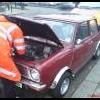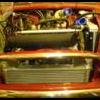Yes but they have a pressure release what comes in at 15PSI so when the water reaches that pressure its releases the needed pressure and if the whole is blocked it can't resulting in high temperatures and overheating.Lots of misinformation here, this thread makes me feel like DILLIGAF....
No coolant wont boil at 100° and all modern cars have a 15-16 rad cap. It is there to hold the system pressurized which means an higher boiling point.
Explanation On Why Rover Engines (Mpi K Series) Overheat
#16

Posted 02 February 2013 - 10:42 PM
#17

Posted 02 February 2013 - 11:01 PM
#18

Posted 02 February 2013 - 11:04 PM
The pressure should be marked on the cap ...PSI when the coolant heats up it creates steam, steam creates pressure and when it gets too much the pressure relief valve opens and lets the extra steam and coolant into the expansion tank until it cools when it enters again.
#19

Posted 02 February 2013 - 11:09 PM
Yes :)What your saying is they all over heat because of the Pressure Relief Valve on the expansion tank fails?
The pressure should be marked on the cap ...PSI when the coolant heats up it creates steam, steam creates pressure and when it gets too much the pressure relief valve opens and lets the extra steam and coolant into the expansion tank until it cools when it enters again.
#20

Posted 02 February 2013 - 11:09 PM
YepSo if the hole is blocked,and cant escape via the cap , it will find its way out thru head gasket, core plug , thermostat gasket etc ?
#21

Posted 02 February 2013 - 11:23 PM
The Rover 214 & 25 were/are excellent cars. In their class, up to 1.4 litre saloon hatchback they drive and ride better than anything else that size. Build quality was great. In fact they were over-engineered. The K-series could develop a HG problem, but so long as metal locating studs were fitted, the head skimmed and a top quality late-type gasket fitted then reliability is good.
#22

Posted 03 February 2013 - 12:25 AM
#23

Posted 03 February 2013 - 07:43 AM
#24

Posted 03 February 2013 - 10:18 AM
#25

Posted 03 February 2013 - 01:09 PM
another popular cause of headgasket issues on alloy engines is people not puting enough antifreeze in and not changing it before it goes acidic.
#26

Posted 03 February 2013 - 05:23 PM
This is mine.
http://www.16vminicl...ead.php?t=27565
#27

Posted 03 February 2013 - 05:42 PM
#28

Posted 03 February 2013 - 05:46 PM
There was a theory that after the MG Rover take over (2000), the K series engines were being made of lower grade aluminium, thus not having great rigidity.
There could be some truth in that.
I bought a brand new '53 1.8 TF (not the VVC) back in 2003. Had it serviced on time everytime by a Rover dealer. Just as the company went bump at 25,000 miles the head gasket blew. Fortunately it blew as the person I sold it too was half way to London. Anyway, I offerred him half of the repair cost to compensate before he could send the heavies round.
Before it blew, I had terrible trouble with door solenoids (part of central door locking) and wiper blade mechanisms under the scuttle. Both parts were of such poor quality that they would literally break up.
Therefore it wouldn't surprise me that the heads blowing was simply down to inferior quality parts fitted that stopped doing the job they were mean't to do.
None the less, I loved my TF, but with a little one on the way it had to go. Wish I'd kept it now, done the head myself and run it how it was originally designed to do.
Edited by DeanP, 03 February 2013 - 05:47 PM.
#29

Posted 03 February 2013 - 05:54 PM
The head bolts are actually technically advanced engineering, the waisted section intentially allows more stretch in relation to tensile loads so the clamping forces are more even. If the bolts were a close fit at the cylinder head mating face they could transfer lateral loads between the castings if they expanded at different rates.
Thats why they're called Stretch Bolts
They should be replaced when re-installing the cylinder head rather than re-used like normal bolts. Usually Stretch bolts require a torque and then a degree of turn so 60nm and 60 degrees.
#30

Posted 06 February 2013 - 01:51 PM
Ones I know off the top of my head - and some have been touched on already.
There isn't much coolant capacity which isn't in itself a problem but as mentioned means things that another engine might survive become a major failure in a very short time (minutes rather than miles).
Plastic intake manifold with rubber O-rings to seal the water jacket. The O-rings perish resulting in coolant weeping down the rear of the block - initially only whilst running so there's no puddle under the car to spot when it's been parked. The lack of capacity means that the amount of coolant you lose on the way to work in the morning is enough that halfway home it will overheat.
Heater valves fail - just failing open isn't a problem, what causes the problem is that they tend to weep when they fail. As above there simply isn't the coolant capacity for the engine to survive unless you spot this as soon as it happens.
The thermostat and it's associated metal pipe along the rear of the block are a pain to get to and inspect or change so stats fail through lack of maintenance resulting in overheating and the steel pipe rusts through (often seemingly from the outside) resulting in coolant leaks and overheating.
There is very little clamping force (relatively speaking) on the head gasket due to the length of the head bolts. It doesn't matter how fancy they are, their length/diameter ratio results in them just twisting if you try to apply a lot of torque. Again this was part of the design and worked fine when everything else was OK but if things get just a little too hot because of another problem then the gasket could "shuffle". Another engine might run hot for 5 minutes till the driver notices and if they switch off, let it cool and add more coolant then they can carry on with no problems (hopefully to the nearest place that will sort the initial problem) a K-Series wouldn't give you that chance because the head gasket just doesn't have that margin. This problem is what the different head gaskets and locating dowels are designed to solve.
1.4's tend to be a bit more resilient because they are a dry liner design - 1.8's are a wet liner and so are a bit more vulnerable to problems. 1.6's are a bit of an oddity being a semi-dry/semi-wet liner (often called a "damp-liner") and so they will survive some abuse that a 1.8 wouldn't but will fail in some cases where a 1.4 would survive.
There have been rumours about the castings - they used a fairly revolutionary method whereby the molten ally was injected into the bottom of the mould. In theory the ******* and impurities float to the top and are then machined off in the normal machining work that the block would have anyway. Problem is that any impurities that don't float all the way to the top (maybe the metal cooled and solidified before they got all the way there, or maybe they got caught on a core) are then embedded in the casting. You also need to inject too much material into each mould knowing that you will be machining some off - the bean-counters don't like this and so try to trim the margins more and more resulting in some blocks where there wasn't enough extra metal to remove from the top to guarantee all the ******* was gone. Obvious problems are spotted and the block is thrown back into the molten alloy vat but non-visible problems......
If it really was as simple as fitting a new cap at every service then do you think it would have been such a problem?
1 user(s) are reading this topic
0 members, 1 guests, 0 anonymous users



















